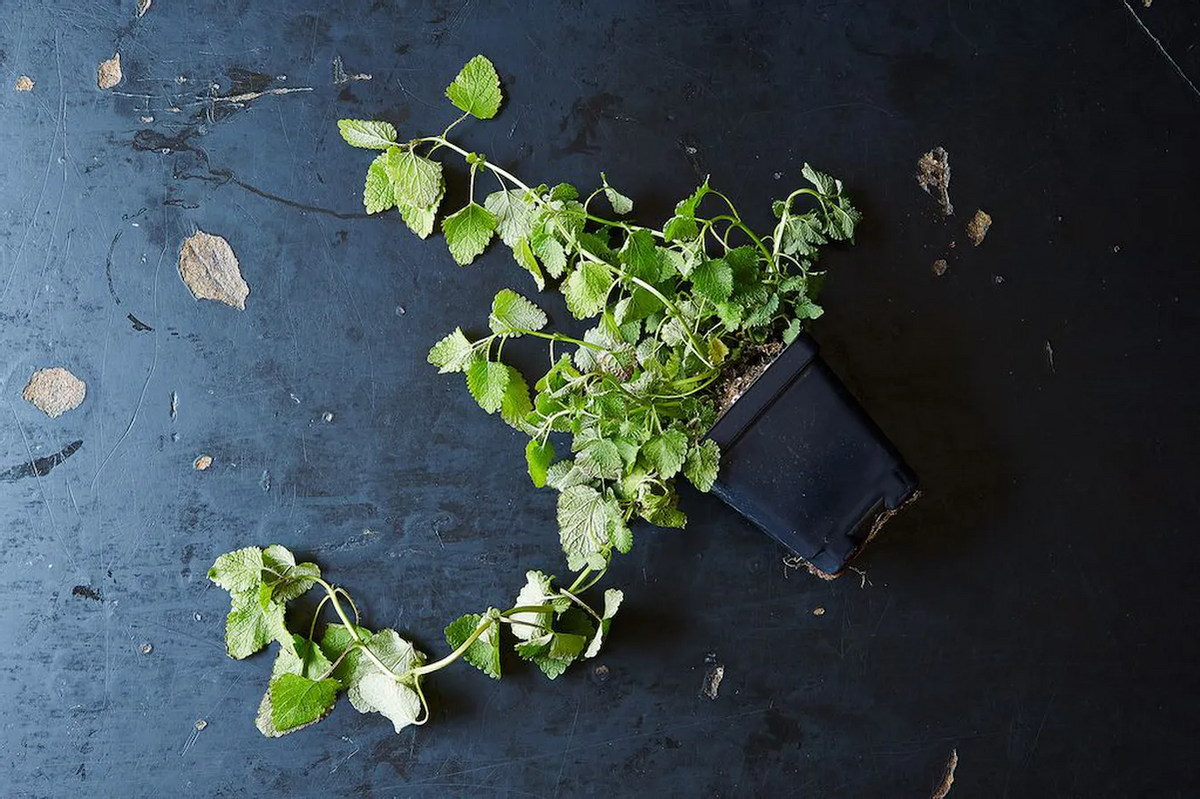The best ways to use lemon balm at home

Every week we get Down & Dirty, in which we break down our favorite unique seasonal fruits, vegetables, and more.
Thanks in no small part to Deborah Madison’s Vegetable Literacy, it has become impossible for us to stroll through a farmers market without thinking about which fruits and vegetables belong to which plant family. One look at lemon balm leaves — whether coarse and hairy in texture, arrowhead or heart-shaped, or scallop-edged — and you’d likely guess that the plant belongs to the same family as mint and shiso, rather than being a direct relative of the lemon fruit. And you’d be right. One more clever deduction, this time from its name, and you’ll figure out that this herb is lemon-scented. Some compare its lemony flavor and aroma to that of furniture polish (and, in fact, the leaves can be used to polish wood), but you’re probably better off putting lemon balm to use in other ways. It’s a culinary wizard and far too prime to use in place of a countertop spray.
The health benefits of lemon balm
This lemon-scented herb (which comes from the Lamiaceae family) is native to Europe and has long been used as a culinary, medical, and cosmetic herb. It’s widely considered to have calming properties, is prized for its ability to reduce stress and anxiety, promote better sleep, and ease indigestion and bloating, according to Mount Sinai. Health studies have shown that lemon balm can increase individuals’ sense of well-being, happiness, and alertness.
Lemon balm (aka Melissa officinalis) has been used medicinally for a long time to treat a wide variety of ailments, most commonly stress and anxiety. Research has somewhat confirmed its calming effect, but you’ll probably pick up on it anecdotally, and we can almost guarantee it will be a beneficial addition to your garden. It’s often planted to attract bees and releases a pleasant lemony scent as you brush up against it. You can even crush the leaves and rub them on your skin as a mosquito deterrent. But that’s not all: Lemon balm will become a go-to herb in your kitchen, too.
How to use lemon balm
As a general rule of thumb, treat lemon balm as you would any other fresh herb. It works especially well in place of mint, offering bright, fragrant notes. Add whole lemon balm leaves to green salads, or chiffonade the leaves and scatter them over a fruit salad for added zesty flavor. Lemon balm also pairs beautifully with poultry — try adding sliced leaves to chicken salad, fish dishes, and even vegetable dishes to serve on the side. Unlike other herbs, you’re less likely to find dried lemon balm in the spice and herb aisle of your grocery store (though you might find it in specialty health stores and online). Give lemon balm tea a try too; it’s just as soothing as chamomile or lavender but with a lovely citrus flavor.
Just like mint or basil, you can also candy lemon balm leaves and use the finished product as a crunchy, crystallized garnish over ice cream or tarts. It also works wonders in recipes that call for lemon verbena (like these cookies) — but note that lemon balm isn’t as intense, so adjust the amounts as necessary.
For a thirst-quenching sip, infuse water with lemon balm leaves, which you can drink as is or use to create granita, a light, icy dessert. After all, nothing is fancier than flavored water. When it comes time for happy hour, “lemon balm makes an absolutely delicious liqueur,” says Greenstuff. Similarly, infuse heavy cream with lemon balm leaves to make panna cotta or crème brûlée.
Seasonality
Lemon balm grows in cold weather and is in season throughout the summer into early fall. Want to plant it yourself? Choose the sunniest spot you can, though it can and will handle a teeny bit of shade. Water it frequently and watch as it grows nearly two feet tall.
Other forms of lemon balm
In addition to the fresh herb, you can also consume lemon balm in the form of an oil or supplement. Lemon balm oils may be cut with water and vegetable glycerin, which just makes it safe to consume orally or used directly on your skin. While it isn’t a cure for any illnesses or diseases, it can act as an aid to soothe sore muscles, reduce inflammation, and even reduce the swelling and redness associated with certain skin conditions like chicken pox, eczema, or psoriasis. Look for organic lemon balm oil made with minimal ingredients from a reputable retailer. Ahead, we’re sharing some recipes that use lemon balm in four refreshing ways.
Our favorite lemon balm recipes
Okra seed “couscous” is a neat, nutty ingredient that shines in this loosely Mediterranean-inspired salad. Thin slices of cucumbers are tossed with fresh lemon balm, sumac powder, and feta cheese, plus the okra, for a light summer side.
There’s not enough good things we can say about these crispy, golden brown vegetarian bites. A handful of fresh herbs such as lemon balm perks up the robust vegetarian mixture made with cannellini beans, bread crumbs, and Parmesan cheese.
Perk up a classic Arnold Palmer with a power-packed blend of fresh lemon balm, lemongrass, lemon verbena leaves, and lemon zest. Combine freshly brewed black tea with the lemon-herb mixture for a cooling sip on a hot day. Beyond this beverage, use lemon balm to make fancy ice cubes or a simple syrup to sweeten any drink.
Radish and Herb Salad with Sungold Tomatoes and Strawberries
Two cups of mixed bright herbs (think: lemon balm, dill, basil, and mint) are a lovely addition to this juicy summer salad. The simplest dressing made from yogurt and maple syrup introduces sweet, creamy notes that coats each element of this dish.

